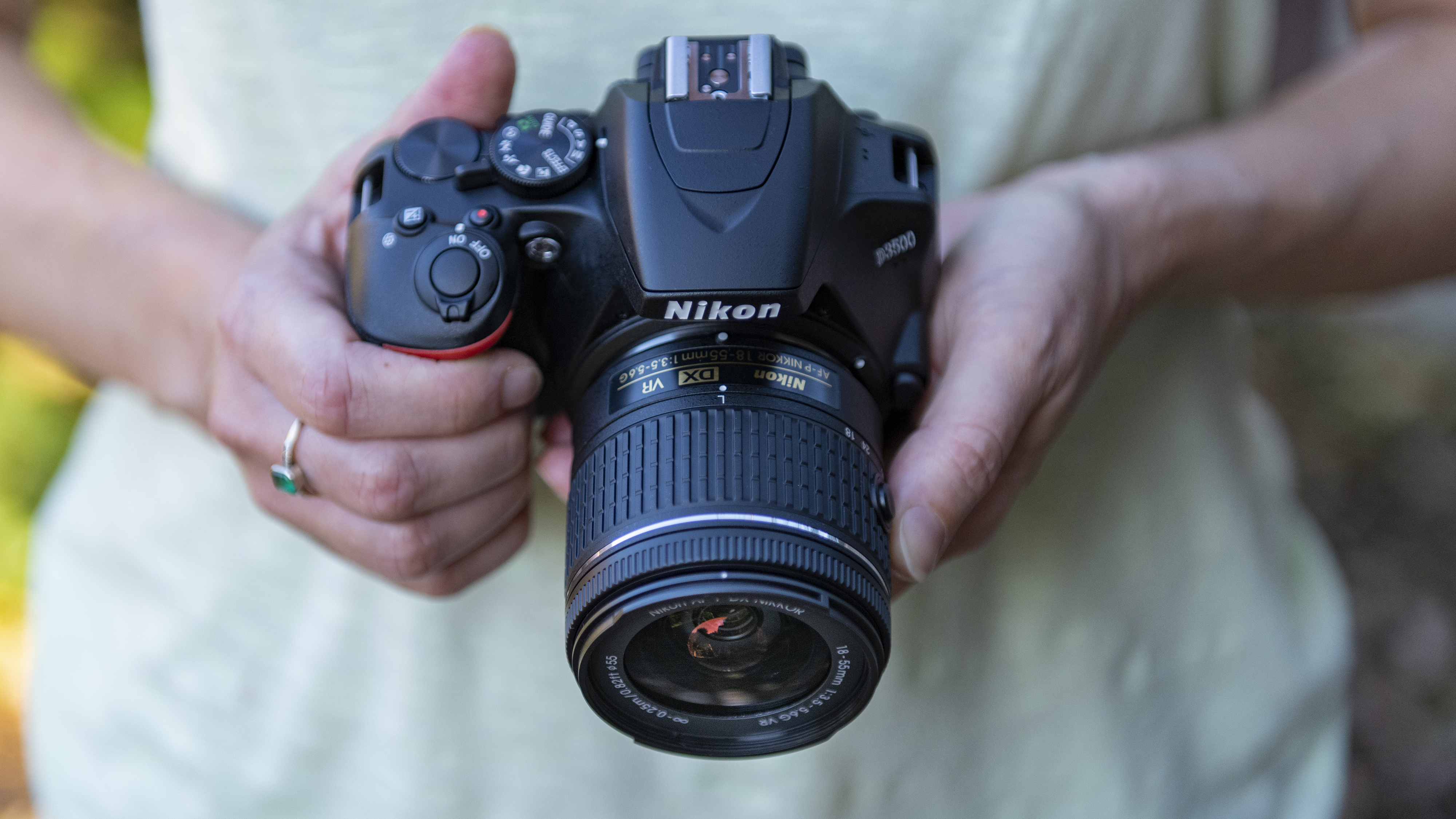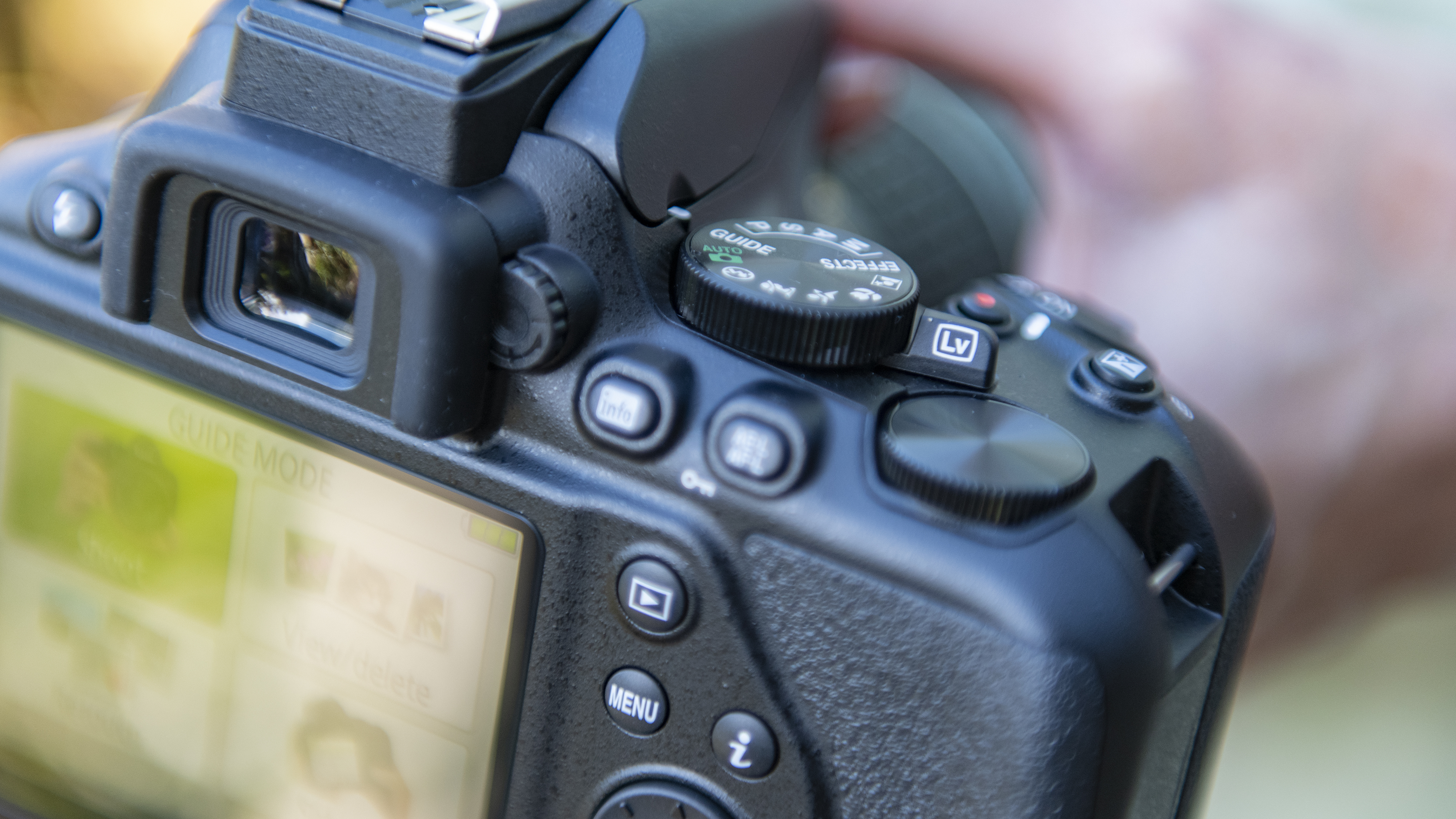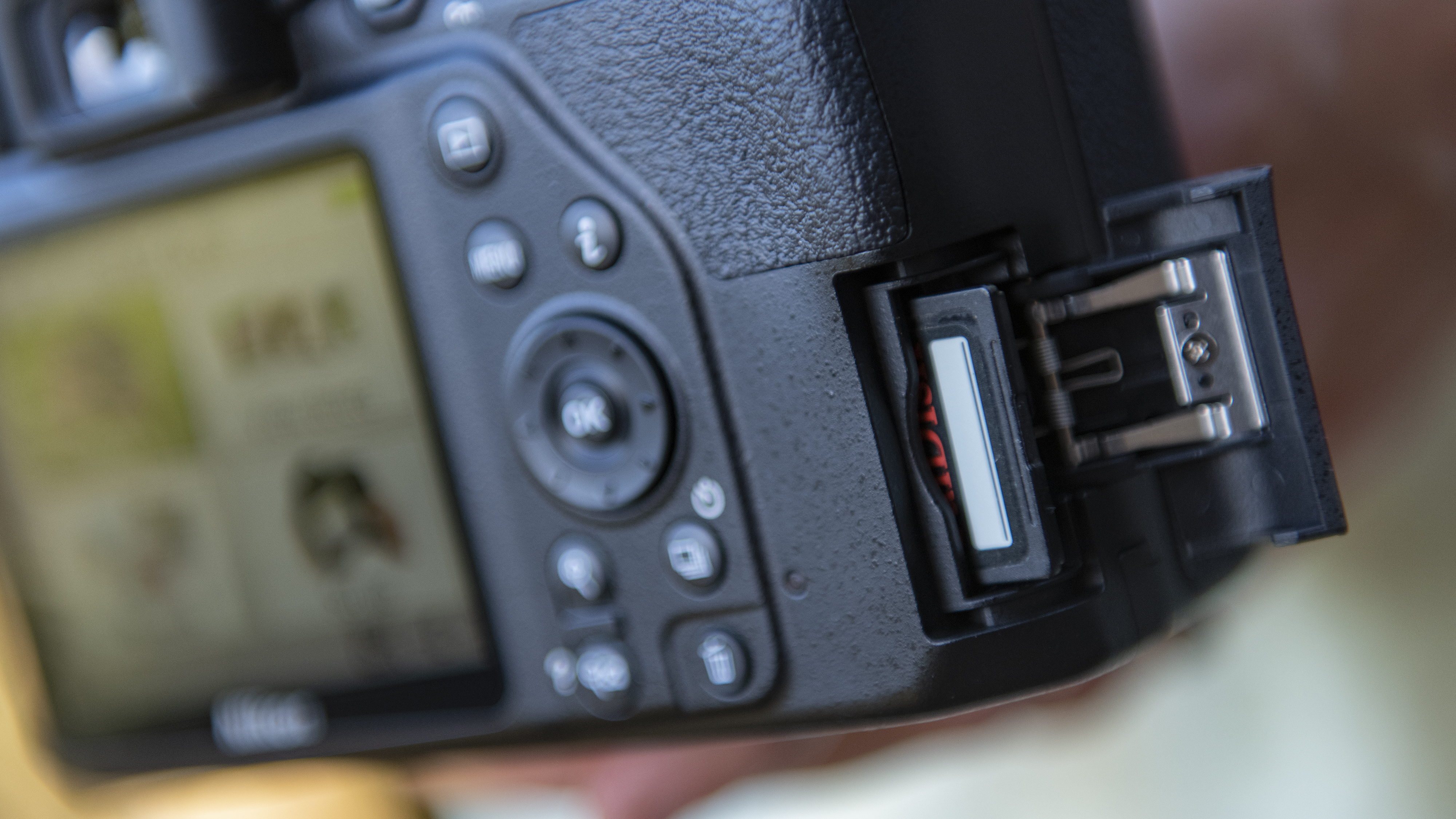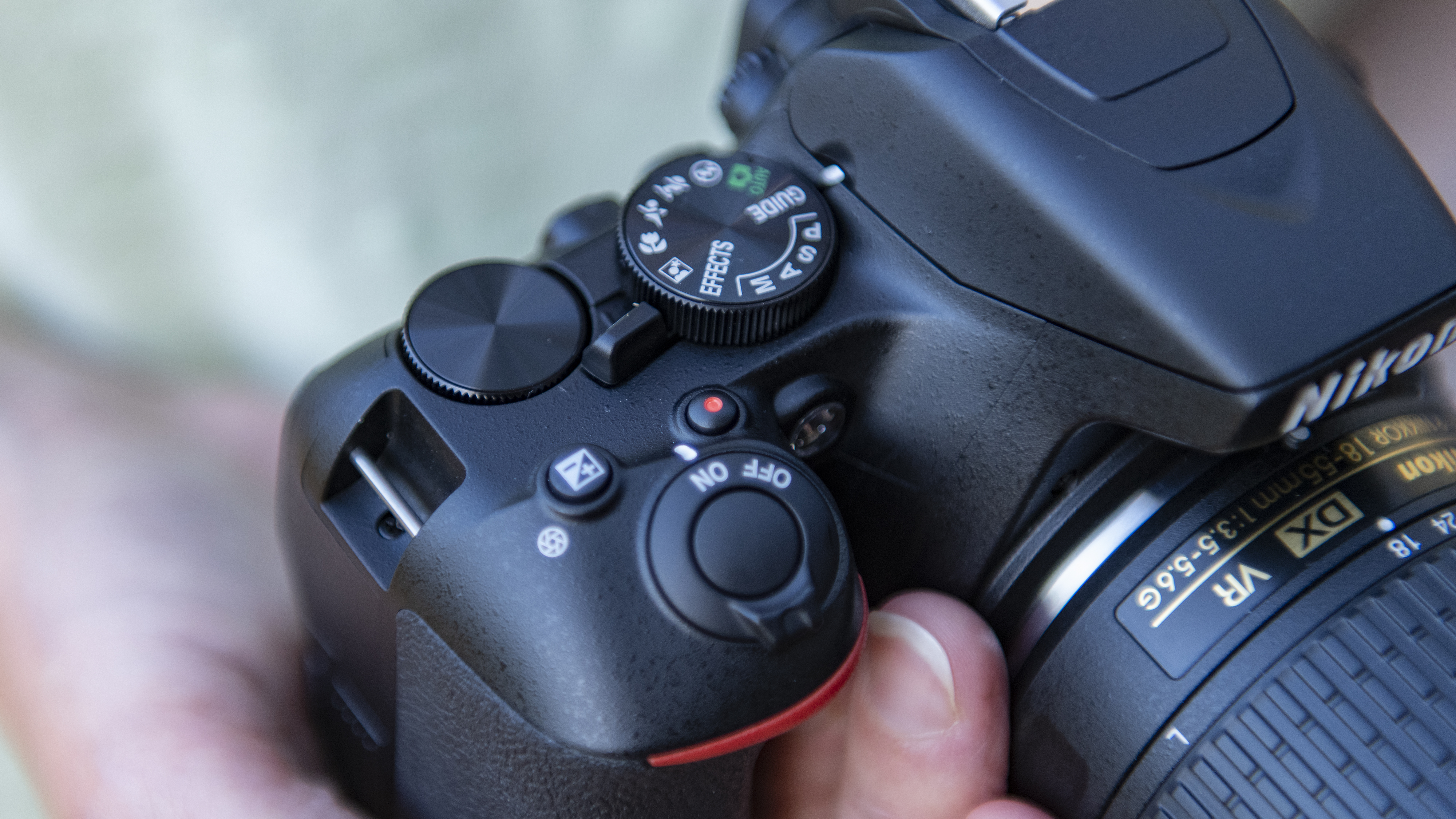Why you can trust TechRadar
Nikon D3500 review: build and handling
- Design quite a change from the D3400
- More substantial grip
- Streamlined controls
While the specification of the Nikon D3500 changed little from the D3400, the design had a bit of an overhaul, with the newer camera more closely related to the mid-range Nikon D5600 aesthetically.
The most notable change is that the grip is now more substantial when you pick the D3500 up. It certainly makes the camera fit comfortably in the hand, while the larger grip also makes it better balanced when shooting with longer and/or heavier lenses.
The larger handgrip hasn't made the D3500 any heavier than the D3400, with Nikon actually managing to shave 30g off the weight, with the D3500 tipping the scales at 415g with its battery installed. Nikon has also reduced the depth of the D3500 by 6mm, with the camera measuring 124 x 97 x 69.5mm.
The top of the D3500 has also been refined over the D3400, and again is now more in line with D5600. There's a fairly streamlined array of controls, with the mode dial now featuring a switch to activate Live View (enabling you to shoot using the rear display rather than the viewfinder) around its collar.
Sitting next to this is a fully-exposed command dial, allowing you to toggle settings like shutter speed and aperture depending on the mode you're in, while the exposure compensation button just in front allows you to quickly fine-tune the exposure if needed.





There are more changes on the back of the D3500. Gone are the five buttons that sat to the left of the D3400's display. Instead, the screen now sits almost flush with the edge of the body, with these controls re-distributed elsewhere on the back of the camera.
There's a dedicated button for the flash to the left of the viewfinder, and an info button to the right of the viewfinder, with the remaining controls arranged around the multi-directional control pad.
For the first-time user, the amount of exterior controls is just about right – making the D3500 approachable without appearing too daunting
A little annoying is the absence of the customizable Fn button that was a handy feature on the D3400, particularly in the absence of a direct control for ISO. This means you have to dive into the menu to tweak the sensitivity, although it's nice to see the dedicated drive mode button hasn't disappeared, which is a control you'll no doubt find useful if you tend to call upon burst-shooting and self-timer options with any frequency.
For the first-time user, the amount of exterior controls is just about right – making the Nikon D3500 approachable without appearing too daunting. Just bear in mind that as your competence develops you may become a little frustrated that some settings can be a little slow to access.
Nikon has also once again implemented its 'Guide mode' feature on the D3500. Designed to help the novice user get to grips with their camera, it provides an alternative to the main menus, and helps the user quickly capture specific types of images. There's also the familiar 'i' button, which can be called upon to explain camera functions.
Nikon D3500 review: autofocus
- Focusing fine for static subjects
- Can struggle when tracking a subject
- Touchscreen absence highlighted when using Live View
The D3500's autofocus system remains unchanged from the one in the D3400 (and the D3300 for that matter).
This sees the same 11-point Multi CAM 1000 AF system that covers a decent amount of the viewfinder in a diamond formation, with the system featuring a couple more AF points than Canon's closest rival, EOS Rebel T7 (known as the EOS 2000D outside the US).
Combined with the AF-P 18-55mm f/3.5-5.6G VR kit lens, and provided your subject isn't on the periphery of the frame, the AF system will do a solid job of locking onto static subjects. Focusing is quiet and, in good light, nice and brisk, although it inevitably slows down a tad in poor light, and it's in these circumstances that we'd look to use the central AF point more, taking advantage of its enhanced cross-type sensitivity.
You'll find that the camera will lock on quicker than if you opt to use one of the outer 10 AF points, while there's also an AF assist lamp to help out when light levels are really low, although this can be turned off if you want, as it can be distracting in some conditions.
With focusing points a little thin on the ground, it can struggle to track subjects as they move round the frame. It's here where a few more AF points would be welcome, as the 11 points are spread out a little too much, resulting in the camera losing your subject if they're not that prominent in the frame.
This is one of the main disadvantages of an entry-level DSLR compared to their mirrorless equivalents, which tend to have wider and more extensive autofocus coverage. Some mirrorless cameras also offer options like Eye AF and Animal Eye AF, although these do still tend to be reserved for mid-range and higher-end models.
If you want to use the D3500's rear display you'll need to switch over to Live View focusing, and this is again where you'll find mirrorless cameras have an edge. While it's possible to focus right to the edges of the frame, focusing speed does take a bit of a knock. The absence of a touchscreen also becomes an issue here, as it can be quite a slow process using the multi-directional pad to maneuver the focusing area around the frame – a simple tap of the screen would be much quicker.
Current page: Build, handling and autofocus
Prev Page Two-minute review Next Page Performance and image qualityPhil Hall is an experienced writer and editor having worked on some of the largest photography magazines in the UK, and now edit the photography channel of TechRadar, the UK's biggest tech website and one of the largest in the world. He has also worked on numerous commercial projects, including working with manufacturers like Nikon and Fujifilm on bespoke printed and online camera guides, as well as writing technique blogs and copy for the John Lewis Technology guide.

